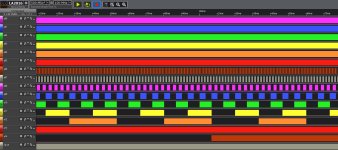Just got a new project, a Zenith 171. Seller described it as failing memory test.
I did my usual intake/evaluation and the first two obvious problems I found were:
- The PSU sometimes would put out some very low voltages. I traced this to the close proximity of C17 and R44/R45 - any moisture in that area (even 91% ipa) would cause it to confuse the opamp and pull the voltgaes very low. Even humidity seems to cause it. The fix was to coat the legs of those three components with a thin layer of uv-cure solder mask.
- Memory test was failing, so I took all the socketed ram (three rows of 41256 and one row of 4264) and run them through the Retro Chip Tester. Found two of them failing. One in row E and one in row B. I replaced the bad 41256 in row E with a known good chip, and removed all the chips from row B. I reconfigured the jumpers for 576k (5 up / 6 open / 7 rt / 8 rt / 9 rt) while I waited for a replacement 4264.
Current status is:
On power up I get message; "Testing Memory" for a few seconds.
Then the screen clears and I get a flashing cursor (the whole character is the cursor, not just a line at the bottom).
No beep or disk seek. System wait here indefinitely.
Comparing with this video of a 171 bootup from LGR:
Mine gets past the memory test and then stops just before the beep wit the flashing block cursor.
Couple of questions:
- In the manual I see that the memory shows the first two rows can have "256" chips and the second two rows have "64". Could the fact that I have 256s in the 3rd row cause a problem? (I'm going to remove all but the first two rows and configure it for 512, see if that helps)
- Does the memory test say something specific if it finds bad memory? I don't recall it saying anything other than "Testing memory" on my first bootup attempt.
- Does it seek the A drive before or after bringing up the world map?
Thanks!
I did my usual intake/evaluation and the first two obvious problems I found were:
- The PSU sometimes would put out some very low voltages. I traced this to the close proximity of C17 and R44/R45 - any moisture in that area (even 91% ipa) would cause it to confuse the opamp and pull the voltgaes very low. Even humidity seems to cause it. The fix was to coat the legs of those three components with a thin layer of uv-cure solder mask.
- Memory test was failing, so I took all the socketed ram (three rows of 41256 and one row of 4264) and run them through the Retro Chip Tester. Found two of them failing. One in row E and one in row B. I replaced the bad 41256 in row E with a known good chip, and removed all the chips from row B. I reconfigured the jumpers for 576k (5 up / 6 open / 7 rt / 8 rt / 9 rt) while I waited for a replacement 4264.
Current status is:
On power up I get message; "Testing Memory" for a few seconds.
Then the screen clears and I get a flashing cursor (the whole character is the cursor, not just a line at the bottom).
No beep or disk seek. System wait here indefinitely.
Comparing with this video of a 171 bootup from LGR:
Mine gets past the memory test and then stops just before the beep wit the flashing block cursor.
Couple of questions:
- In the manual I see that the memory shows the first two rows can have "256" chips and the second two rows have "64". Could the fact that I have 256s in the 3rd row cause a problem? (I'm going to remove all but the first two rows and configure it for 512, see if that helps)
- Does the memory test say something specific if it finds bad memory? I don't recall it saying anything other than "Testing memory" on my first bootup attempt.
- Does it seek the A drive before or after bringing up the world map?
Thanks!

